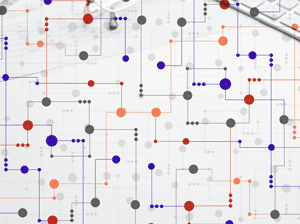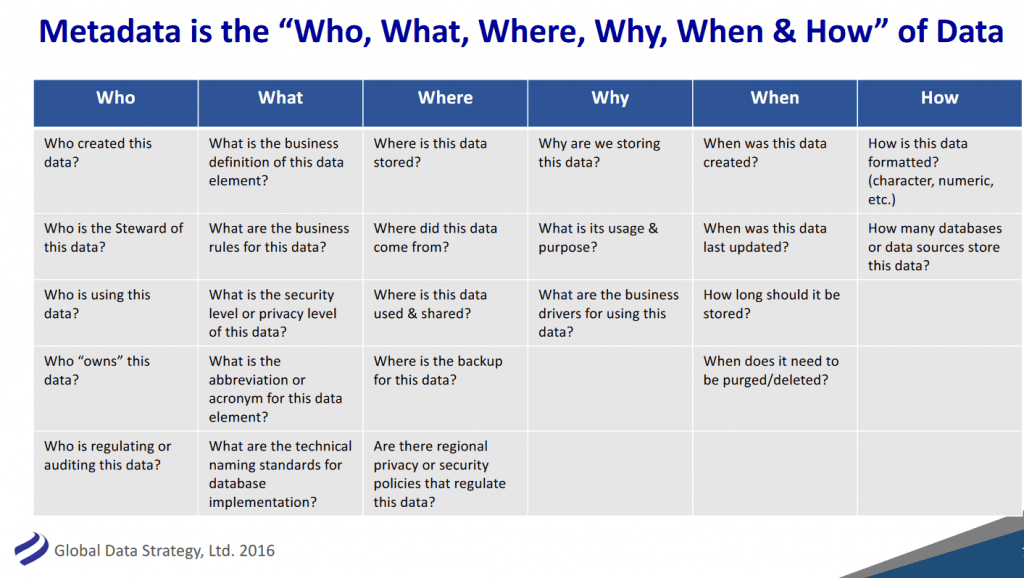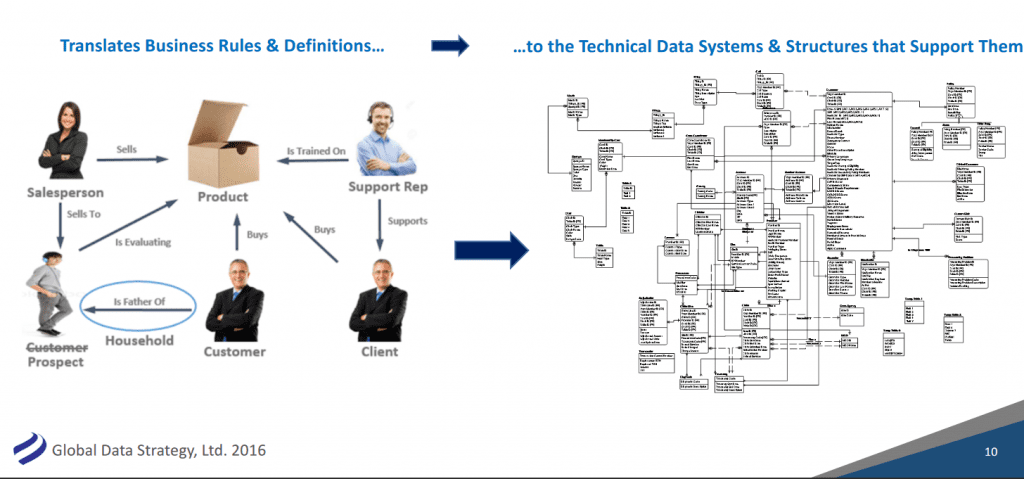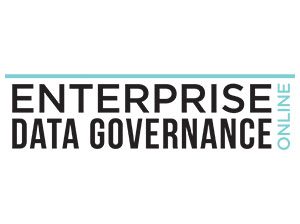 “Data Models can be the critical link between business definitions and rules, and the technical data systems that support them,” said Donna Burbank, Managing Director of Global Data Strategy, while speaking during her presentation Building Actionable Data Governance through Data Models & Metadata at the DATAVERSITY® Enterprise Data Governance Online 2017 Conference.
“Data Models can be the critical link between business definitions and rules, and the technical data systems that support them,” said Donna Burbank, Managing Director of Global Data Strategy, while speaking during her presentation Building Actionable Data Governance through Data Models & Metadata at the DATAVERSITY® Enterprise Data Governance Online 2017 Conference.
She discussed how Data Models can be used to create and maintain a Metadata-driven Data Governance program in an organization. Burbank has over 20 years of experience in Data Management, Metadata Management, and Enterprise Architecture, with experience on the “process and consulting side of things” as well as the “nitty-gritty technical – how you actually get it done and make it actionable” she said. This session focused specifically on “how things like Data Models and Metadata Management can help you do that.”
Data Modeling Links Policies to Action
“Data Governance is always referred to as the people, process, and policies around data and information, but
if you don’t have the process together and the people sponsoring, you’re not going to get any buy-in.” Burbank recommended starting by clarifying your business goals and objectives, and ensuring they are relevant.
“You could have the best Data Governance program with all of the best people and processes, but if nobody cares, and it doesn’t align with the business they are doing, then it doesn’t matter,” she said.
A good way to encourage buy-in early on is to go for a quick, high-visibility win so that people get curious and ask, “‘Can I have one of those? Not sure what you called it. I guess, it was ‘Governance?’ but it seemed to work, and I’d like one,’ and things like Metadata can help with that,” she said.
Just as critical to success is the technical infrastructure supporting the data systems that run the business, “Data Models are the critical link between those business definitions that are part of the people-process-policies, and the actual rules of the data systems that implement them.” Beyond that, it’s also possible to introduce automation into your Data Governance program so that it becomes ‘business as usual’ and not “just another thing I need to do,” she said.
Metadata is Data in Context
Metadata creates context for your data, and “Helps you understand what you are seeing,” she said. Showing a slide with columns for the ‘who,’ ‘what,’ ‘where,’ ‘why,’ ‘when,’ and ‘how’ of data, she presented a series of questions that can be used to start gathering information about data.
- Who created this data?
- Who is the Data Steward using it?
- Who ‘owns’ it?
- What auditors do we need to comply with?
- What’s the business definition?

Image Credit: Global Data Strategy
Referring to the ‘what’ column, she said, “A lot of this can be stored in either a Metadata Repository and/or a Data Model,” and in terms of Regulatory Governance, “Are there privacy tags we need to link?”
Metadata is Hotter than Ever and Data Governance is a Key Driver
The DATAVERSITY® Emerging Trends in Metadata Management white paper discussed that 80 percent of survey respondents said that Metadata Management is more important than ever. Metadata Management is also the most requested topics by DATAVERSITY readers and conference attendees. “It’s not this old-fashioned quaint notion that no one has time to do anymore,” Burbank said.
Another finding from the survey showed that more than 60 percent of respondents chose Data Governance as the main driver behind their use of Metadata Management. “People are understanding that having policies around Data Governance and then implementing them effectively relies heavily on Metadata,” remarked Burbank.
What Can a Data Model Do?
A Data Model translates business rules and definitions into the technical data systems and structures that support them, she said. She showed a slide of a simple business model with pictures of ‘client,’ ‘customer,’ ‘support rep,’ and ‘product,’ on the left side of the slide and a series of tables representing sources and repositories of a company’s data on the right.

Image Credit: Global Data Strategy
“The Data Model on the left might not look like your typical Data Model, but I’m a big fan of using these cartoon-type Data Models,” she said. Burbank uses them successfully with almost all her clients because it allows them to sum up – in one page – the company’s connection between the data and the working structure it supports.
“The point of a Data Model is to get those business rules and business definitions and those core concepts that need to be governed; the core domains and the core business terms that we will be using – because that drives you to think of your conceptual, logical, and physical layers in the typical Data Modeling world. That’s going to drive the technical systems. So each of these things on the left, you’ll probably have in a customer table or many customer tables.”
Without a high-level view of what needs to be managed and governed in simple terms, it’s impossible to effectively implement it on your system, so in one sense, she said, this shows what a Data Model can do.
Using the upcoming General Data Protection Regulation (GDPR) as an example, Burbank showed how a Data Model could be used to help with Personally Identifiable Information (PII) compliance policies and procedures.
“Our policy is that all PII should be anonymized if we’re going to start sharing it between departments. You can’t share sales data or credit card data, or customer usage patterns” if it contains PII. “It has to be genericized,” she remarked. Yet ‘customer name’ could appear in a multitude of ways across each different system, she said. “That’s the kind of gap that the Data Model can help with – translating these policies into actual technical rules that can be implemented by the people that are running the systems.”
When the PII regulation changes, a Data Model can answer the question, ‘Which fields in our database constitute PII?’ It’s even possible to link the actual language from the GDPR driving the PII policy to the Data Model so it’s clear where the policy originated, she said. Knowing where all PII lives in the system can also make it possible to calculate the impact of a requested change, she said. A Data Model is, “A tool that helps translate regulations, policies, and procedures to the actual technical systems that support them.”
Types of Metadata
Technical Metadata describes the structure, format, and rules for storing data. Business Metadata describes the business definitions, rules, and context for data. Data represents the actual instances (e.g. John Smith). “The beauty of the Data Model, in my mind, is that it can really handle both,” Business and Technical Metadata, she said. Another type of Metadata is the historical information carried in what Burbank calls, ‘Human Metadata.’
“Joe has been with the company for 20 years and ‘oh, yes, that part number, we used to call that component number before the acquisition.’ It’s pretty important if you’re trying to get consistent part numbers and they’re all in different systems. Joe might be the only one who knows that.”
Joe’s knowledge of former naming conventions can be put in the Data Model, as well as information that ‘everybody just knows,’ letting your Data Model serve as a repository for institutional memory.
A Data Model as ‘Living Policy’
“Where many Data Governance projects start – and there’s very good reason for this – is something like a Business Glossary. What are the key terms, the key metrics that people need? Are we all defining the ‘northeast region’ in the same way? And if we’re going to report to the street, we’d better be, so let’s all get together and at least get some of the core terms that are critical defined in a similar way.”
Data Stewards and the areas they link to, business definitions, privacy levels, security levels – anything relevant to Data Governance. “You can actually store these in your Data Models so they’re a ‘living policy’ that stays with the data as Metadata, as well as in your technical structures,” said Burbank.
A Data Model can clarify the difference between ‘client’ and ‘customer,’ and whether PII applies to client information, for example. “A lot of these really basic questions could be answered by putting the model in and publishing it out,” she said. Governance properties or attributes like the name of the steward for a domain can also go right in the model and be published, she said.
“’I have a question. That’s not my definition of customer. Who do I go to?’ ‘Well, go to Phil, he will have an answer.’ All the stuff that you will put in the policy, you can actually link in the model, so then the person actually building the database doesn’t have a question. It’s right there and could be linked to actual actionable things.”
Supporting Consistency and Metadata Sharing
A Data Model doesn’t need to be a huge repository. It can be a ‘just enough’ Metadata Repository to start.
“If a lot of your Metadata, especially around governance and your relational databases and your business definitions are in the Data Model, use that Data Model as your kind of control point for a lot of these definitions,” she said.
There are also third-party tools that can translate historic definitions from wherever they sit in the system into the “single defined source that was in your Data Model.” A basic report with a figure for ‘total revenue’ depends on consistent naming for accuracy, yet figures for total revenue could be stored under a multitude of names. Burbank said that an intelligent Data Modeling tool can facilitate differences in naming painlessly. “It doesn’t have to change your database, which is often what scares people.”
Technical Metadata Makes Data Governance Progress
“The beauty of Technical Metadata and [using] a Data Model as one source of that really makes this idea of Data Governance actionable, so you can have a policy or procedure and you can publish it and that’s great. But even in the best of cases where you have a fully motivated staff, there’s a grey area. ‘When you said ‘name’ was private and we can’t share ‘name’ outside of the company, is that first name? Is that last name? Is that a nickname? They’ve got an online persona; can I share that?’”
A Data Model can provide the history, the terminology, the policy, and the connection to a person (if needed) who can help put Data Governance into action.
Data Modeling can be a rich source of Metadata, helping people support policies and procedures defined by Data Governance. By providing consistent standardization of business and technical definitions, and linking them with business rules, Data Modeling supports and facilitates ‘actionable’ Data Governance. “Things like Data Stewardship, data ownership, and policies can all live in the documents that your team are using to actually make the databases,” she said.
Check out Enterprise Data Governance Online at http://datagovernanceonline.com/

Here is the video of the Enterprise Data Governance Online 2017 Presentation:
Photo Credit: Khakimullin Aleksandr/Shutterstock.com
